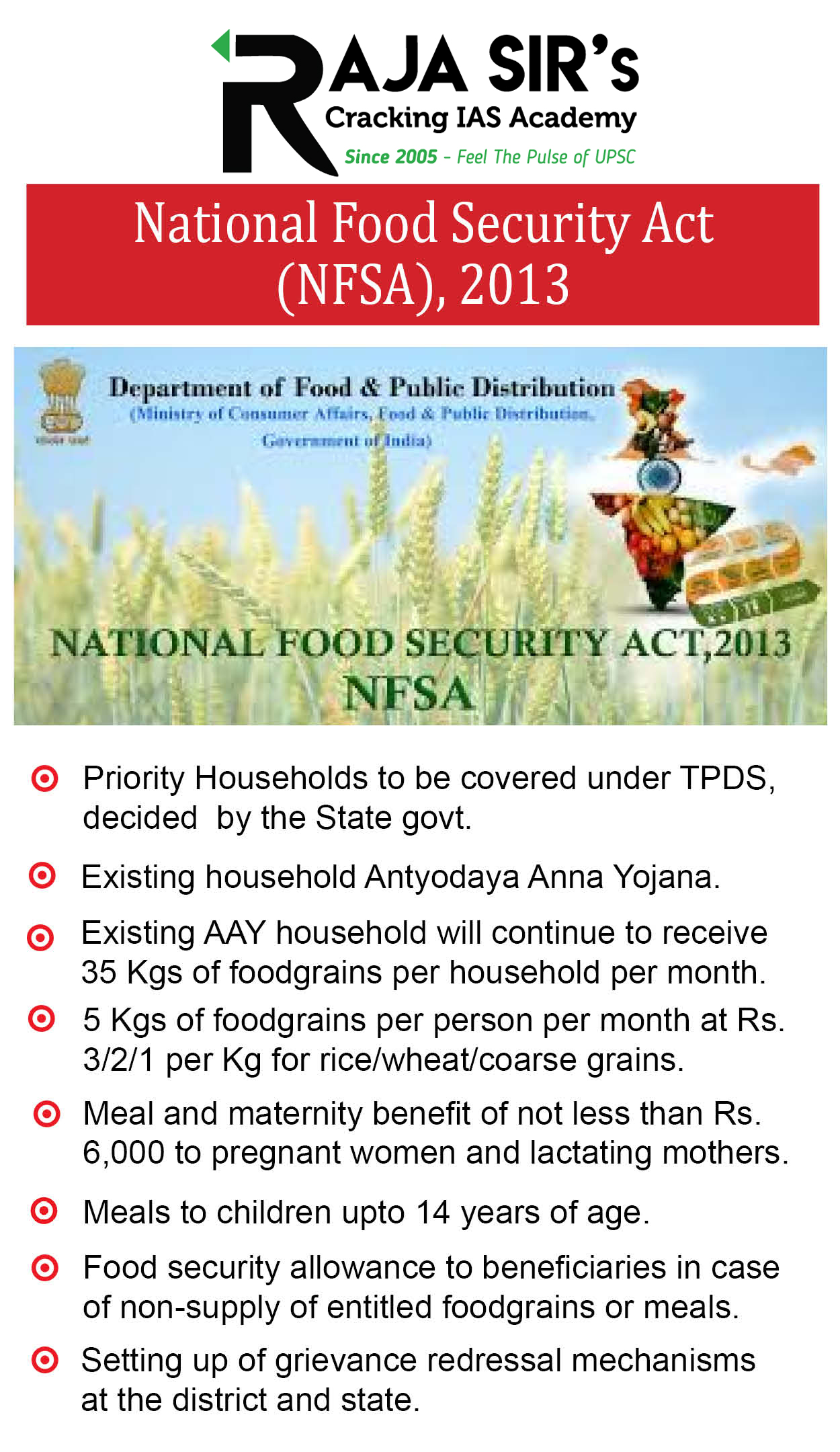- Home
- Prelims
- Mains
- Current Affairs
- Study Materials
- Test Series
Food safety net must be expanded without any delay
- The National Food Security Act (NFSA), 2013, through the Public Distribution System (PDS), provides a crucial safety net for roughly 800 million people.
- In response to the humanitarian crisis, the Government doubled the entitlements of the 800 million who were already covered by the PDS (from five kilograms per person per month, to 10kg). But that does nothing for those without ration cards.
- The humanitarian crisis resulting from the COVID-19 lockdown, made it apparent that too many were still excluded from the PDS.
The National Food Security Act (NFSA), 2013:
- The issue of ''food security'' at the household is continuously being addressed by the Government since long, through the Public Distribution System and the Targeted Public Distribution System.
- The enactment of the National Food Security Act, (NFSA) 2013 on July 5, 2013 marks a paradigm shift in the approach to food security from welfare to rights based approach.
- The Act is being implemented in all the States/UTs, and on an all India basis, out of maximum coverage of 81.34 crore persons, around 80 crore persons have been covered under NFSA at present for receiving highly subsidized food grains.
 Features of NFSA 2013
Features of NFSA 2013
- Coverage and entitlement: Up to 75% of the rural population and 50% of the urban population are covered under the Targeted Public Distribution System (TPDS), with a uniform entitlement of 5 kg per person per month.
- Antyodaya Anna Yojana (AAY) households-35 kg per household per month
- Subsidised prices: Food grains under TPDS are made available at subsidised prices of Rs. 3/2/1 per kg for rice, wheat and coarse grains.
- Identification of Households: It is done by States/UTs.
- Eldest woman of the beneficiary household (18 years or above) is considered as ''Head of Family'' to issue ration cards.
- Grievance Redressal Mechanism: Grievance redressal mechanism at the District and State levels.
- Maternity Benefit: Pregnant women and lactating mothers are also entitled to receive maternity benefits of not less than Rs. 6,000.
- Transparency and Accountability: Provisions have been made for disclosure of records relating to PDS, social audits and setting up of Vigilance Committees to ensure transparency and accountability.
Issues Involved
- Government during COVID -19 doubled the entitlements of the 800 million who were already covered by the PDS (from five kilograms per person per month, to 10kg. However it does not cover those without ration cards.
- The Exclusion Problem: This could be because the NFSA coverage ratios were too low to start with, or due to the ‘freeze’ in coverage in absolute terms (around 800 million).
- Between the last Census in 2011 and today, population increase has not been accounted for in determining the number of ration cards.
- The 2021 Census has been postponed indefinitely. This means that even a decadal update has not happened.
Problems and Miseries of Migrant Labourers Case
- The Supreme Court agreed that the prayer to increase coverage “seems to be genuine and justified”.
- It directed the Union of India to “come out with a formula so that the benefits under NFSA are not restricted as per the census of 2011.
- Supreme Court said that the Government could consider “projection of population increase” to resolve this issue.
- Response by the Government:
- Any change or revision in the number of beneficiaries would necessitate an amendment in the Act. As Section 9 of the NFSA requires that coverage be determined on the basis of the latest census published.
- On the basis of NITI Aayog’s view, the Government responded that the “prime concerns” while fixing the ceiling at the time of enactment of the NFSA was that “as standard of living of people would improve over a period of time, the coverage may be reduced.
Issue with the Government’s Response
- The Government relies on logic: As per capita income has increased, the vulnerable population “would have gone down considerably”. However an increase in the average does not necessarily imply an increase for everyone.
- Government attempts repeatedly to shift the blame to State governments but States are responsible for identifying people for PDS ration cards.
Coverage by States
- Several State governments have used their own resources for instance states such as Chhattisgarh and Odisha expanded coverage beyond the centrally determined quotas.
- There were 809 million (in 2020) NFSA PDS beneficiaries supported by the central government. An additional 90 million people got benefits through their State governments. States were subsidising another 51 million people, but their entitlements were less than those of NFSA beneficiaries.
Looking ahead
- Robust procurement trends and a comfortable food stocks position make an expansion affordable.
- Adjusting for population increase, as directed by the Supreme Court, will increase coverage by roughly 10% (from 800 million to 900 million).
- This is nothing when compared to the doubling of food subsidy resulting from the “double ration” (10 kg per person per month) provision granted as COVID-19 relief to 800 million existing ration card beneficiaries.
- The Government should not delay any further in providing the additional coverage of roughly 100 million across States.
- Government should make sure that poor people should not pay the price for the state’s failure in conducting the 2021 Census.









 Latest News
Latest News
 General Studies
General Studies